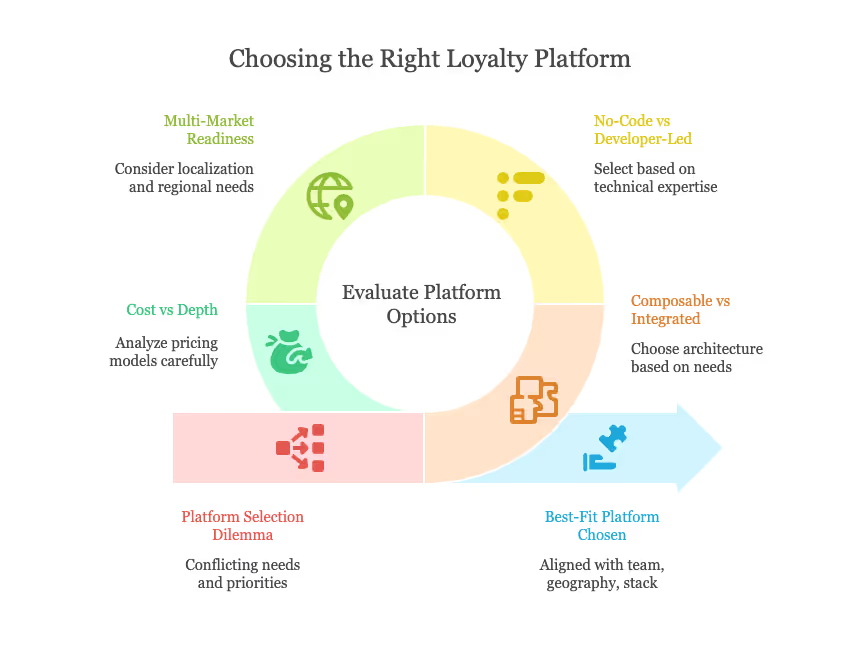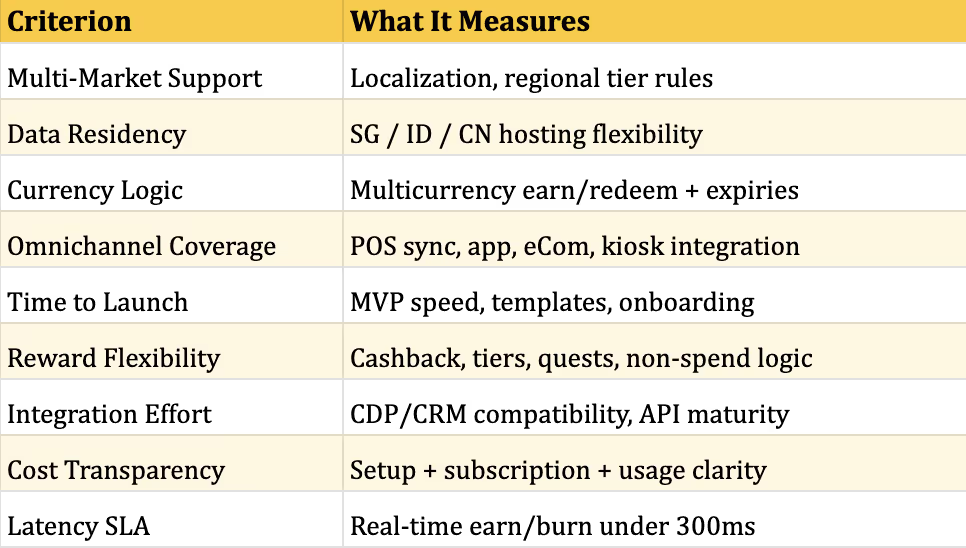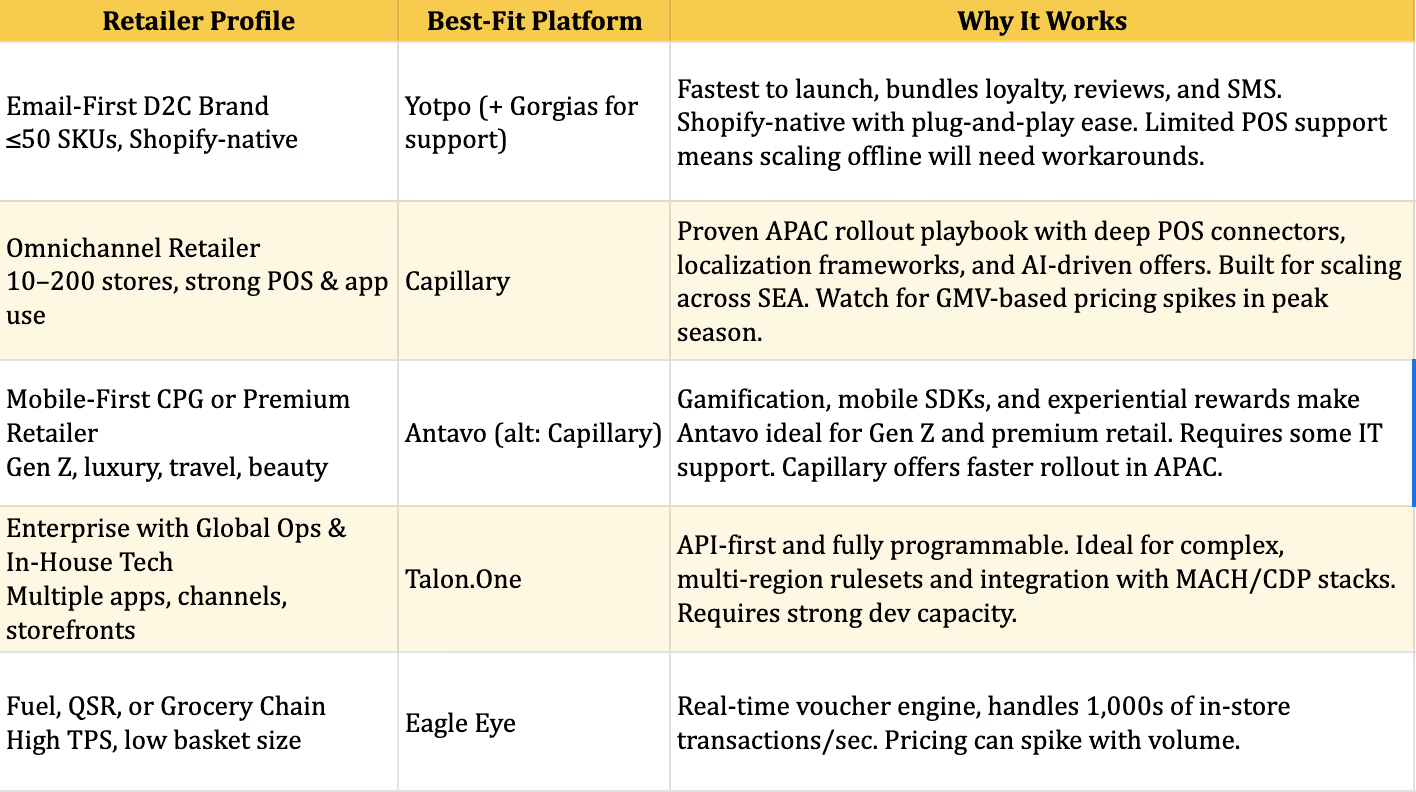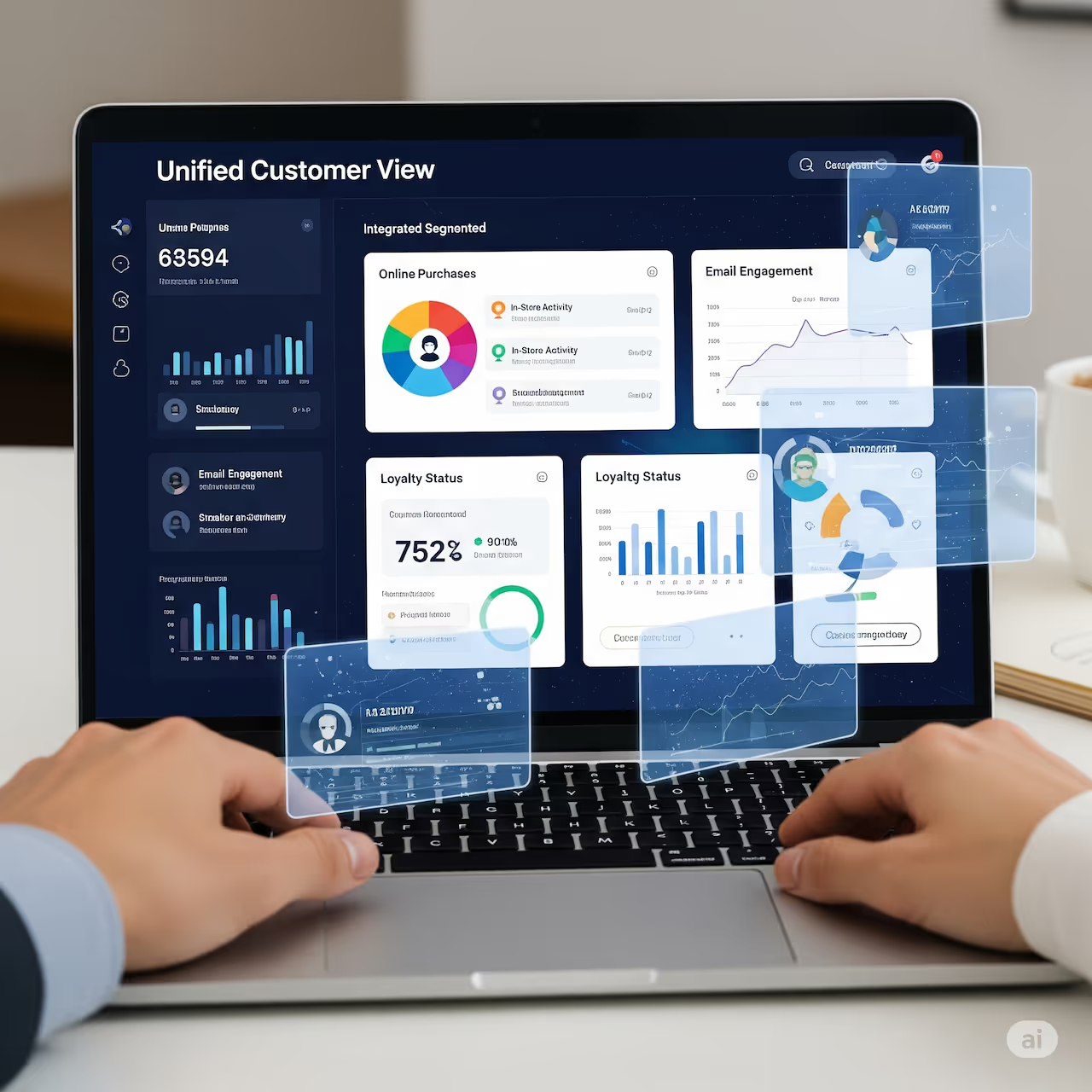Loyalty isn’t just a points game anymore—it’s a data infrastructure challenge.
In APAC, where customer behavior varies dramatically by market—and mobile-first journeys dominate—retailers are rethinking loyalty from the ground up. The old playbook of stamp cards and basic earn-burn mechanics no longer cuts it.
Mid-market brands today need loyalty platforms that can:
- Orchestrate real-time engagement across in-store and digital touchpoints
- Personalize offers using first-party behavioral data
- Operate across regions, currencies, and languages without operational drag
The stakes?
Choose wrong, and you’ll face fragmented data, slow personalization, and costly rework. Choose right, and loyalty becomes a growth lever—boosting LTV, speeding up campaigns, and reducing integration debt across markets.
But which platform delivers without locking you into a vendor, region, or legacy stack?
In this post, we break down five leading loyalty platforms—from plug-and-play to programmable—and help you find the right fit based on use case, architecture, and regional readiness.
The Platforms: Five Contenders for APAC Dominance
Here's how five prominent loyalty platforms stack up for APAC-focused brands:

*Delivery-From contract to MVP under standard integrations. Pricing varies by GMV, MAU, or event volume
Platform Highlights
- Capillary: Deep regional experience with APAC-first architecture with a large established regional client base. Strong for retail chains needing POS integration and regional compliance.
- Antavo: Best for brands needing flexible, gamified programs across markets. Supports sustainability and non-spend rewards. API-first and suited for composable stacks.
- Yotpo: Ideal for Shopify-native brands looking for speed. Combines reviews, loyalty, and SMS in one suite. Limited support for offline or complex regional logic.
- Eagle Eye: Built for real-time promotions and high-volume POS environments. Common in fuel and grocery sectors. Less focus on personalized or gamified loyalty.
- Talon.One: Developer-centric platform with maximum flexibility. Ideal for complex rule-based programs and teams running advanced, composable tech stacks
But features alone don't tell the whole story—it's about what you're willing to trade off
The Trade-Offs Behind Each Platform
Once you’ve shortlisted features, the real questions begin: Speed or flexibility? Simplicity or control? Global reach or local nuance?
Here’s how those choices play out.
Composable vs. Integrated Architecture
Yotpo and Capillary offer bundled suites—loyalty with SMS, reviews, and personalization—ideal for Shopify-led brands that want speed and fewer vendors. But swapping out one part later may force broader replacement. Antavo and Talon.One are composable by design. Their APIs and rule engines plug into existing CDPs, CRMs, or orchestration layers. Setup takes more effort, but brings long-term control.
No-Code vs. Developer-Led
Capillary and Antavo offer visual builders and templates. Non-technical teams can launch tiers, quests, or multipliers with minimal lift. Yotpo excels here for Shopify, but is limited beyond core channels. Talon.One and Eagle Eye require technical ownership. Promotions are defined in code or JSON, supporting complex reward logic across POS, apps, even IoT. It’s more effort upfront, but delivers scale-ready flexibility.
Multi-Market Readiness
In APAC, “multi-country” means more than language packs. You need localization, regional tier logic, varied tax regimes, and dashboards that roll up metrics globally. Capillary leads with prebuilt taxonomies and rollout frameworks across India, SEA, and ANZ. Antavo supports this too, but setup may be more custom. Yotpo suits single-market D2C but lacks regional depth. Talon.One is global-ready, but relies on strong dev teams.
Cost vs. Depth
Not all pricing models scale well. Eagle Eye’s POS adjudication is fast but costly at high volumes. Talon.One’s event-based pricing is predictable, but can spike in low-basket, high-traffic settings. Capillary’s GMV-based model looks light at first, but seasonal peaks can erode margins. Antavo’s steady pricing may require premium tiers for advanced logic.
Bottom line: The best-fit platform depends on your team’s bandwidth, geographic spread, stack philosophy, and cost profile, not just features.

Evaluation Framework: Decision Criteria Matrix
Not all loyalty platforms are created equal—and feature checklists don’t reveal the real effort behind integration, localization, or scale.
Use this 9-point matrix to rate contenders on a 1–5 scale:

Buyer Checklist: 10 Questions to Pressure-Test Your Loyalty Platform
Before you commit, run every platform through these questions with your team and the vendor. They’ll surface integration risks, scalability gaps, and negotiation levers early.
10-Point Buyer Checklist
Pressure-test platforms before you commit:
- Does it support multi-country logic—without rebuilding from scratch?
- Can you choose data hosting (SG, ID, CN) for compliance?
- What’s the POS sync latency—under 300ms?
- Can marketers configure rules visually—no code?
- Are CDP/CRM connectors prebuilt?
- What’s the average go-live time for similar brands?
- Can it handle non-transactional and coalition rewards?
- Is pricing predictable across high and low seasons?
- Can you export customer data easily?
- Is the vendor stable, and does the roadmap align with your goals?
Final Guidance by Scenario
So, which platform should you choose? It depends on your context:

Beyond Points and Redemptions
Loyalty today isn’t just about rewarding spending, it’s about stitching together fragmented systems, regional nuances, and evolving journeys.
In APAC, where mobile-first habits, cross-border ops, and data sovereignty collide, your loyalty engine must flex with you.
Start with three questions:
- What markets are you expanding into?
- How complex will your logic get?
- Who owns loyalty- marketers or developers?
The right platform delivers:
Speed (launch fast), Governance (stay compliant), and Modularity (scale without rework).
Get that right, and loyalty becomes a growth lever, not just a retention checkbox.
.avif)

.avif)


.avif)